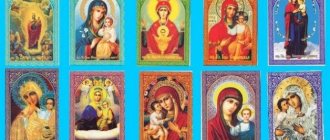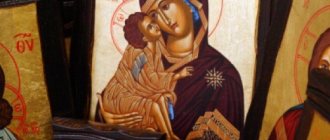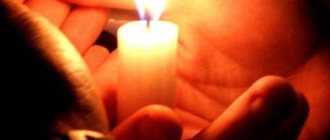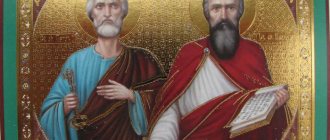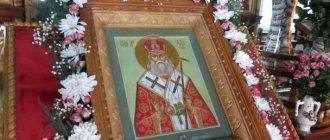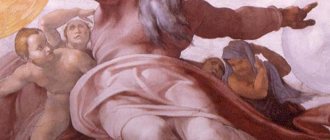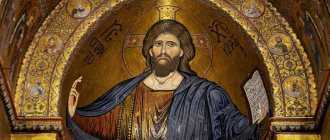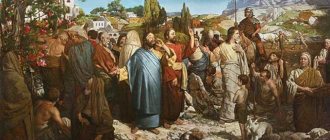Article on the topic
Prayer capital. Moscow has its own Belt of the Virgin Mary and other shrines
“To put it simply, the psychological basis of veneration of icons lies in the well-known saying: “It’s better to see once than to hear a hundred times,” says psychologist Ilya Samoilov. The fact is that many of us perceive 80% of all information we receive through vision. Such exceptional importance of visual impressions apparently made people persistently desire to see God. The Holy Scriptures tell how Christ’s disciple Philip asked his teacher: “Show us the Father, and it will be enough for us” (John 14:8). “An icon is not so much an image as a sacred object through which the grace of God is given to the one praying, the holiness coming from God is communicated,” the Russian Orthodox Church explained to AiF. “And this happens regardless of who exactly is depicted on the icon: the Lord, His Most Holy Mother or one of the saints.”
It is generally accepted that it does not matter which icon to pray in front of - new or old, at home or in church. The main thing is to do this with a pure heart and good intentions. In principle this is true. Nevertheless, there is a huge difference between an ordinary image, consecrated in a church and hung in an apartment, and a prayed church icon created many centuries ago. It is no coincidence that it is precisely such images—with a centuries-old history—that become miraculous. A sign of a miraculous icon are numerous healings that have become widely known. As a rule, images of old writing, high artistic level and relatively large sizes are endowed with such fame. The popular consciousness attributes miracles to the icon as a whole, and not just to the face depicted on it. Copies (or lists) - even exact ones - are not credited with healing. For example, the Vladimir Icon of the Mother of God is found in many churches and private homes, but only one, kept in Soviet times in the State Tretyakov Gallery, is considered miraculous. In September 1999, she moved to the church-museum of St. Nicholas in Tolmachi at the gallery.
The main thing, when going on a mini-pilgrimage to the chosen image, remember that performing a miracle, that is, fulfilling a prayer, primarily depends on the faith of the person praying. “If you can believe as long as you can, all things are possible to him who believes” (Mark 9:23). However, if the one who pronounces the prayer with his lips does not have a conscious and heartfelt appeal to God, then the prayer uttered even in front of the miraculous icon itself will remain fruitless.
In the upcoming issues, AiF will tell you about the most revered relics kept in Orthodox churches in Moscow.
The most famous miraculous icons of Moscow
1. The miraculous Tikhvin Icon of the Mother of God. They pray for the sight of the blind, for illnesses in children, for relaxation of joints, for paralysis, and from the invasion of foreigners. Temple in honor of the Tikhvin Icon of the Mother of God in Alekseevsky. St. Church Hill, 26a, st. m. "VDNKh". 2. Icon “Merciful”. They pray for the birth of children. Zachatievsky stauropegic convent. 2nd Zachatievsky lane, 2, st. m. "Park Kultury". 3. Vladimir Icon of the Mother of God . Authorship is attributed to the Apostle Luke. She is considered the intercessor of Russia. It is customary to pray in front of this icon for the well-being of the entire country. The most famous icon of Rublev “Trinity” is also located there. Church of St. Nicholas in Tolmachi at the State Tretyakov Gallery. M. Tolmachevsky lane, 9, st. m. "Tretyakovskaya". 4. The icon “Quench my sorrows” will help you overcome life’s difficulties, misfortunes and adversity . Church of St. Nicholas in Kuznetskaya Sloboda. Vishnyakovsky lane, 15, st. metro stations "Paveletskaya", "Novokuznetskaya". 5. Icon “Unexpected joy”. They pray for the health and happiness of the children, asking for troubles to be resolved. Temple of the Icon of the Mother of God “Unexpected Joy”. St. Sheremetyevskaya, 33, st. m. "Maryina Roshcha". 6. Icon “Unexpected joy”. Second list. Restores health to children and helps them find strength. Temple of Elijah the Prophet, 2nd Obydensky lane, 6, st. m. "Kropotkinskaya". 7. Icon of the Mother of God “Life-Giving Source”. Those suffering from physical illnesses and spiritual infirmities pray. Icon of the Mother of God “Jerusalem”. They pray for fire, for healing from blindness and paralysis. Temple in the name of the prophet Elijah in Cherkizovo. St. B. Cherkizovskaya, 17, st. m. "Preobrazhenskaya Square". 8. The miraculous Iveron Icon of the Mother of God (from the destroyed chapel at the Resurrection Gate). They pray for deliverance from various misfortunes and for consolation in troubles. The miraculous icon of the Mother of God “Passionate” (from the Passionate Monastery). They pray for healing from blindness, relaxation, and fire. Church in honor of the Resurrection of Christ in Sokolniki. Sokolnicheskaya square, 6, st. m. "Sokolniki". 9. Icon of the Mother of God “Joy of All Who Sorrow.” All the offended, suffering, and in despair pray in search of consolation. Sorrow Church on Bolshaya Ordynka. St. B. Ordynka, 20, st. m. "Tretyakovskaya". 10 . Icon of the Mother of God “Vsetsaritsa”. They pray for healing for cancer. Novospassky stauropegic monastery. Krestyanskaya square, 10, st. m. "Proletarskaya". 11. Myrrh-streaming icon of the Martyr Tsar . They pray for the fate of Russia, as well as for forgiveness for the death of Nicholas II and his family. Church of St. Nicholas in Pyzhi. B. Ordynka, 27a/8, st. m. "Tretyakovskaya". 12. The miraculous icon of the Mother of God “Tenderness” .
Revered by the Venerable Seraphim of Sarov, according to the faith of those who ask, she gives healing. Kazan Icon of the Mother of God. Those getting married pray to her. Icon of the Mother of God "Mammal". Nursing mothers and pregnant women pray for a safe delivery of their pregnancy. Epiphany Cathedral in Yelokhov. St. Spartakovskaya, 15, st. m. "Baumanskaya".
Icon “The Legend of Which Saints Are Given Which Graces of Healing by God”
More details about the icon “The Legend of Which Saints Which Graces of Healing were Given from God”
LIST OF THINGS DEPICTED ON THE ICON:
Holy martyrs and confessors Gury, Samon and Aviv - on resolving problems in marriage and reconciling husband and wife Holy Martyr Thomaida, St. Maron the Hermit, St. Basil - from the shaking disease St. John the Baptist - on healing headaches Image of the Most Holy Theotokos The Burning Bush - from fire and lightning Hieromartyr Antipas Bishop of Pergamon - on the healing of dental diseases The Venerable Romanos and Hypatius - from infertility and childlessness The Holy Great Martyr Nikita - on the deliverance of infants from their relatives The Venerable Niphon Mnich and Saint Maruf - on driving away evil spirits The Holy Wonderworkers and Unmercenaries Cozma and Damian - on enlightenment and learning to read and write St. Onuphrius the Great, St. Zadok, St. Barbara, Hieromartyr Harlampy - on preservation from sudden unrepentant Death Kazan Icon of the Most Holy Theotokos - on the sight of those blinded by the eyes of the Holy Martyrs Login the Centurion, Mina the Egyptian and Archdeacon Lawrence - on the healing of eye disease Holy Apostle John the Theologian - about the study of icon scriptures Holy Martyr Artemy - from a celiac disease Holy Martyr Konon Gradar - about the healing of infants from smallpox Holy Great Martyr Panteleimon - about the healing of human ailments Reverend Moses Murin and the Holy Martyr Vnifanty - about deliverance from wine binge Holy and Righteous Simeon the God-Receiver - about health of babies Guardian Angel daytime Tikhvin image of the Blessed Virgin Mary - about preserving the health of babies Guardian Angel night St. John the Long-suffering, holy martyr Thomaida and St. Martinian - about deliverance from fornication St. Nikita, Bishop of Novgorod the Wonderworker - about preservation from fire and lightning Holy Glorious Prophet Elijah - about lack of rain and a bucket The Holy Martyrs Florus and Laurus - from the equine case The Venerable Paisius the Great - about deliverance from the torment of those who died without repentance Saints Blasius Bishop of Sebaste and Modest Patriarch of Jerusalem - from the bestial case The Holy Martyr Catherine of Alexandria - from the difficult birth of a baby Theodore's image of the Most Holy Theotokos - from the difficult birth of a baby St. Nicholas the Wonderworker - about deliverance from drowning Hieromartyr Cyprian and the Holy Martyr Justina - about preserving charm from evil Holy Great Martyr George the Victorious - about preserving livestock from animals Saints John the Warrior and Theodore Tyrone - about finding stolen things
All saints, pray to God for us!
The gift of healing is always twofold: natural or miraculous.
Healers and natural doctors treat with knowledge and skill, and the Church has never forbidden people to turn to them.
The Holy Church forbids its children to resort to the help of only those “healers” who, although they can sometimes perform “miracles” of healing, use sources of dark energy, and therefore the relief of physical suffering occurs at the expense of spiritual fall and captivity. These are fortune tellers, sorcerers, sorcerers and modern psychics known since ancient times, often unaware of the energy they use.
Even during their lifetime, canonized saints often performed miracles of healing from various ailments with the assistance of the grace of the Holy Spirit, without demanding reward for their work, remembering the command: “Freely you have received, freely give.” And after leaving this world, they continue to help many when people turn to them in prayer.
“Prayer is prayer, and doctors are doctors,” says Saint Felphan the Recluse, “God gave doctors, and it is God’s will to turn to them. The Lord comes with His help when the natural means He provided for us are not enough.
... When you are sick, going to the doctor is not a sin, even though the illness is from God: for God gives healing intelligence, and God created medicines. Therefore, when resorting to a doctor and medicine, we will not resort to what is outside of God’s ways and institutions. These conspiracies are not God’s, there is no point in going there.
...You can choose not to undergo treatment, determining yourself to be patient, but you must be afraid that arrogance might creep in: let the weak be treated... and we are strong! Thinking about yourself this way results in grumbling. It’s better this way: the disease comes, get treatment. The pain will go away from the medicine - thank God. If it doesn’t work, you have to endure it and thank God.
... Help, Lord, your daughter to benefit from treatment. Let him pray and ask the Lord to enlighten the doctors, so that they can guess the disease and come up with the proper medicine. For the Lord heals. The healer is His instrument.
...Ask humble doctors, they will frankly say that they themselves do not know how healing prescriptions are written. So, if you, trusting in God and receiving help from Him, and not from doctors and drugs, turn to natural means of healing, then there is no sin. When God has given these means, then one must turn to them.”
Prayer and akathist to the “Healer” icon
The celebration of the icon dates back to October 1.
Troparion of the Mother of God before the icon of Her Healer
voice 1
To Love, Pure Virgin, Your holy icon to those who venerate/ and the true Mother of God to those who glorify/ and faithfully worship/ the Healer who appears,/ removing all evil and disease from these,/ like the Almighty.
Troparion of the Mother of God before the icon of Her Healer
voice 4
Like the Most Bright Star, asking Your holy image for Divine miracles, Healer, grant us, Mother of God Mary, healing of mental and physical ailments, salvation and great mercy.
Kontakion of the Mother of God before the icon of Her Healer
voice 6
The intercession of Christians is not shameful, the intercession to the Creator is immutable, do not despise the voices of sinful prayers, but advance, as the Good One, to the aid of us who faithfully call Thee: hasten to prayer, and strive to entreaty, ever interceding, the Mother of God, who honor Thee.
Prayer to the Most Holy Theotokos in honor of Her “Healer” icon
Oh, Most Holy Lady Queen Theotokos, the highest of all heavenly powers and the holiest of all saints! We fall down and worship You before Your all-honorable and wholesome image, remembering Your wondrous appearance to the sick clergyman Vincent, and earnestly pray to You, the all-powerful intercessor and helper of our family: just as in ancient times you gave healing to that cleric, so now heal our souls and bodies, sick with the wounds of sins and many different passions, deliver us from all misfortunes, troubles, sorrows and eternal condemnation, save us from soul-destroying teachings and unbelief, from the flattering and arrogant attacks of invisible enemies, grant us a Christian death, painless, peaceful, shameless, to partake of the Holy Mysteries and grant us worthy to the impartial judgment of Christ stands at the right hand of the All-Righteous Judge and hear His blessed voice: “Come, blessed of My Father, inherit the Kingdom prepared for you from the foundation of the world.” Amen.
( 2 ratings, average: 5.00 out of 5)
Icon of the Mother of God “Tenderness” (Seraphim Tenderness or Joy of all joys)
The icon was the cell icon of the Holy Righteous Seraphim of Sarov. It depicts the Mother of God at the moment of the Annunciation, when Archangel Gabriel brought her the news of her birth of the Savior of the whole world. “Behold, the Servant of the Lord, let it be done to me according to your word” (Luke 1:38) - said the Virgin Mary after the Annunciation.
Saint Seraphim of Sarov prayed in front of this icon, and died in front of it, kneeling during prayer. Before the revolution, the icon was in the Trinity Cathedral of the Seraphim-Diveevsky Monastery. Since 1991, the icon has been kept in the Patriarch's residence in Moscow. Once a year, on the day of the Praise of the Most Holy Theotokos (Saturday of the fifth week of Great Lent), the icon is brought for public veneration to the Epiphany Cathedral in Moscow (https://www.elohovosobor.ru) and an akathist is read before it.
All articles
Icon of the Mother of God “Joy of All Who Sorrow”
The name of the icon comes from the initial line of the Mother of God stichera: “Joy to all who mourn and the offended to the Intercessor...”. The Mother of God is depicted standing in the center of the icon, holding the Divine Infant in her arms. The Mother of God is surrounded by grieving sinners, subject to various sorrows and ailments, and by angels who, on behalf of the Mother of God, bring relief to people.
The image was glorified in the 17th century, after the healing of the Patriarch’s sister, Evfemia Petrovna Papina, from a serious illness. One day, while praying, Euphemia heard a voice that commanded her to serve a prayer service before the Icon of the Mother of God “Joy of All Who Sorrow” in the Temple of the Transfiguration of the Lord. After the image was found and a prayer service was served, the woman was completely healed. Numerous cases of healing through prayers in front of this icon are known, occurring to this day. That is why on November 6, the day of the icon’s celebration, queues of pilgrims stand in front of the icon, wanting to venerate the shrine. Now the icon is located in the Church of the Icon of the Mother of God “Joy of All Who Sorrow” (Transfiguration of the Savior) on Bolshaya Ordynka (https://ordynka.com), on the left side.
Who painted the revealed icons? By people or is it given to us from above?
Listen:
O. Oleg: - Radio Radonezh live. As usual on Sundays, Archpriest Oleg Stenyaev and Vladimir Nosov are on air. Good evening.
V. Nosov: - Father, we are starting the broadcast with tragic news. A week ago, on Forgiveness Sunday, all residents of Russia were shocked by the monstrous news about a terrorist attack, a crime committed by a young man in the Dagestan city of Kizlyar on the territory of an Orthodox church. He entered the territory and shot five women who came out after the service, just after the end of the Rite of Forgiveness. I would like to draw attention to this. All the dead were women. And among them was the one whom local residents and parishioners called blessed. A parishioner named Ira. She behaved truly heroically. She attacked this insane terrorist, a non-human, and began to hit him with her bag, thereby saving the people who were in the temple. This scoundrel had a lot of bullets. She always sat near the temple and was killed by a bullet in the chest. The parishioners spoke touchingly about this woman. Many helped her with food and money. Father, I would like to somehow celebrate this feat. How would you advise: each of us may have a difficult situation in which we will need to make a decision quickly, clearly and correctly. How to act, how to behave in such extreme situations?
O. Oleg: - In fact, no one knew how he would behave. And fantasizing about this topic is wrong and indecent. But Irina showed an example of self-sacrifice. On the one hand, there is an armed man. We have already watched how they storm maternity hospitals there, in the Caucasus, and seize schools with children. And here the attack on elderly women does not require much courage. And when a woman with a bag at the ready rushes at an armed man, tries to stop him, gets shot in the chest - this is real courage and a manifestation of love for people. As it is said: “Greater love has no one than to lay down his life for his friends.” In fact, such a decision cannot be deliberate, because it occurs in a state of shock. But, as psychologists say, in such moments the true qualities of a person are revealed. You can see his real face, which in a normal situation we cannot always see. A woman just sat and collected alms. But the way she behaved in an extreme situation is true courage. In contrast to this young man, who came armed towards the elderly women, shot, reloaded, and shot again. This characterizes both sides, but in different ways.
V. Nosov: - You know, father, recently there was a great holiday - the Triumph of Orthodoxy. It seems to me that this is that very celebration.
O. Oleg: - I think you can say that, because when a person sacrifices himself for the sake of others like this, this is Christianity. Love in the Christian understanding. Now in the world, love is understood as consumer behavior; love is only a source of pleasure. But true love is sacrificial. She is ready to sacrifice her interests for the sake of other people.
Question: - Tell me, who painted the revealed icons? By people or is it given to us from above? For example, icons of the Iveron or Vladimir Mother of God?
O. Oleg: - In fact, any icon arises as a result of a certain vision that a person of holy life receives. Spiritual reality is not a hallucination, but a miraculous insight. And he then reproduces this vision on the board, and subsequent icon painters can only make lists. Or a person experienced a vision and guided the icon painter, retelling to him what he saw, because not everyone can see the colors of that world. It must be said that, for example, in the 13th chapter of the first letter of the Apostle Paul to the Corinthians, the apostle writes: “Now we see through a glass darkly.” There are few people on earth who truly contemplate the realities of another world and want to share them. Why is it important? So that we do not mistake for divine that which is not. Why did the Cherubim cover their faces when communicating with the Lord? In order not to accept for God that which is not God. Because this is a serious danger. And if during prayer a person identifies his subjective idea of the object of prayer with the object of prayer itself, then this can be very dangerous. Therefore, for us, the icon represents, so to speak, a canonical, passionless image. There is a legend that the Vladimir Icon goes back to the Evangelist Luke himself. And many such legends have existed since ancient times regarding various images. Of course, Christian communities wanted to have some kind of testimony from eyewitnesses themselves, who actually saw the Lord with their own eyes, who touched Him with their own hands. There is a detailed description of the appearance of the Virgin Mary. Moreover, it is written down: hair color, face, manner of speaking. And all this was dear to Christians because it strengthened faith and helped to better organize prayer in order to avoid their subjective ideas, fantasies, and hallucinations. Because it is dangerous to accept as divine something that is not such, but some kind of our personal fantasy.
V. Nosov: - Father, I know that you really like Znamenny chant and hymns, but what icons do you like to pray in front of?
O. Oleg: - I like to pray in front of the icons that are in the canon, I can’t stand modern painting, so - I don’t understand modern church hymns. All this Italian stuff, all these Baroque composers, and so on..... I remember, when I was a subdeacon, I heard the Cherubimskaya performed in one of the Moscow monasteries, and the music was Mozart. "The Marriage of Figaro", a hymn of love. I have an ear for music. When I heard the Cherubic in the monastery, the music of Mozart, the famous title of this work, these modulations - I was amazed: well, what is this? Also in the icon. An icon is not a painting painted by El Greco, Raphael or anyone else, it is unclear from whom they copied these icons. A real icon is an illumination for a spiritual person, and he already conveys everything to us through the icon and lists.
Question: - There are many parables in the Gospel in which the Master or King is present. In particular, Luke has a parable about the called and the chosen. Why was the Master angry? And why is he menacing and cruel in parables? If this is the image of the Lord, then he should probably be upset if those invited did not come, and he became angry. Why is he so menacing?
O. Oleg: — In fact, parables are connected with everyday life. At that time the ruler was a very serious person. For example, we had a ruler, Ivan the Terrible. Do you know that at that time the word “formidable” did not mean what it means now? Then this word meant “fair”. That is, the concepts “formidable” and “fair” were identical. Ivan III was also called the Terrible. And this word meant severity for the sake of justice. In fact, there are different parables, and not just about kings, lords, and rulers. Today in the temple where I serve, we studied the 15th chapter of the gospel of Luke. There was a parable about, let's say, a housewife and for housewives. Christ also had parables for fishermen, how they threw a net into the sea; for the peasants, as the sower went out to sow; and for citizens who had interaction with government officials. And the parable of the housewife: the lost coin, when a woman had 10 coins and she lost one of them in her house. She lit a lamp and with a broom began to look for this coin. He searches until he finds it. I don't think there's anything strict here. But in each case, the Lord understood those people to whom he addressed. And the genre of parables is stories, fairy tales that are told so that we recognize the spiritual meaning behind these stories. It is easier and easier for people to understand when a story is told figuratively. It was accepted at that time. If we take the Jewish literature of that time: Mishma, Gemara - there are a huge number of midrashim, these are short parables. There the animals talk to each other, and some events are described, because Christ even spoke about accidents. You heard: the tower fell, so many people died. Don't think they were worse than you. If you don't repent, the same thing will happen to you. He used different ways to make people think. This was a very common genre when presenting spiritual instruction in the form of a parable or a short story.
Question: — In some places in the Gospel we see concepts such as “neighbor.” As a rule, we discuss who this closest one is. And there is the concept of “friends”. Do I understand correctly that a neighbor is someone who is nearby and needs help? And the second question - friends are everything, is it everyone or not?
O. Oleg: - Let's first remember the parable about our neighbor. The famous parable of the Good Samaritan. Christ told this parable, answering the question: who is my neighbor? And in this parable he showed that a person of a different faith may turn out to be a neighbor, not belonging to the true faith, but to a false one, but nevertheless possessing moral qualities. In this parable we see that a man who fell into the hands of robbers was beaten. And the right priest ran past, the Levite also ran past. But the heretic Samaritan stopped and took care of this man. And Christ, when he told this parable, asked: who is the neighbor of this beaten man? And the Jews answered that the one who showed him mercy. Christ showed that even a person of a different faith can become a neighbor if his personal qualities correspond to this. Because if we reduce the concept of neighbor to the concept of someone who is next to us, then some kind of enemy may be nearby. And we can’t be around some people. It is said: blessed is the man who does not walk in the counsel of the wicked, who does not stand in the path of sinners, and who does not sit in the assembly of the wicked. Therefore, a neighbor is a person who has certain moral qualities. He may differ from us both in religion and nationality. Of course, it’s great if our neighbor is our brother in faith and brother in blood, and in general a person from our cultural and religious space. It will be easier for us to communicate with him, we will understand him better, and he will understand us better. But if we talk about friends, then friends are co-workers. Strictly speaking, in the biblical sense, a friend is not a person for fun - to go and play rounders together. A friend is, rather, a comrade. Comrade in Russian means a person who does the same job with me. By the way, such a word appears in the Bible. Not only Pushkin, not only the socialists. It means people who do the same thing. That is, they are comrades, comrades, in principle, friends. Something unites them. Otherwise they wouldn't be each other's friends. At least from the biblical context, this is how I see these two different words. Neighbor and friend. Christ once told his disciples that he called them friends. After He initiated them into the truths of faith, He said that they were not slaves, but His friends. Because He raised them to a certain level of truly human life, since He Himself was a true man. He perceived them as a continuation of his own human life, not divine, but human.
V. Nosov: - The Lord called the one beating Him a friend.
O. Oleg: - This is also present. In the original Greek this is the word. It hardly refers to a comrade who is engaged in the same business - Christ did not beat or beat anyone, but this man behaved aggressively. Perhaps with this word “friend” Christ wanted to calm a person’s aggression, to reason with him, to show him that He is not against him, He has no anger towards him. He just wants to understand why they do this.
Question: — A person dies in a foreign land. There is no contact with my only daughter. And there is no hope that the deceased was buried according to Orthodox custom, but most likely she was simply cremated. How to properly perform an absentee funeral service? And if the daughter did perform the funeral service for the deceased, is it permissible for the funeral service to be held twice?
O. Oleg: — If you don’t know for sure, then it’s acceptable. Moreover, you can order the land to be consecrated. Although if you don’t know the burial place, you can’t deliver anything there, then go to the nearest cemetery where you have someone buried, dig a hole, and put it there. This was how it was customary: when a person did not appear for a long time, time passed, he was declared dead, a funeral service was performed, and when someone close to him died, a letter was also sent for him. But this was usually a long process, if it was not known exactly whether he died or did not die, or went to war, went somewhere. There were no telephones then. But still the procedure existed. If you are not sure whether he is dead or not, incarcerated or not, buried or not, then it is better to do it. Explain the situation to the priest, he will advise how best to proceed.
Question: - 18th Kathisma, what does it mean in the service? Because after the 9th hour it is read in the Canon. And another question: If prayer has become relaxed due to health reasons, then how can I return to the previous state of spiritual uplift?
O. Oleg: - Reading the Psalter is an action that presupposes the blessing of a spiritual mentor, because in the practice of the Russian Orthodox Church of the Moscow Patriarchate, morning prayers, which we read, evening prayers and prayers before communion are required. For everything else we must ask the priest for a blessing. For example, you are given a blessing that you will read the Psalter for a week or a month. And you want to know the meaning of this or that kathisma. In fact, it is easier to find out the purpose of a psalm, because in ancient publications the inscriptions are written in red, in which cases this or that psalm is read. This is a very ancient tradition, going back to the time of the Second Temple. I saw a Jewish edition with such inscriptions, for interest I compared it with the Orthodox inscriptions, in which cases which psalm is read. And I was surprised when I saw that it matched. This means that since the time of the Second Temple, the purpose of the psalm has not been lost in time. Although these two traditions, Jewish and Christian, diverged sometime around the second half of the 1st century AD. But all this indicates that, perhaps, these inscriptions go back to King David or his entourage, when they knew for what occasion David wrote this or that psalm. In the case of kathismas, such inscriptions are not always present.
Question: — For a long time I have been taking a blessing from my confessor for a relaxation of fasting, I am old, have many illnesses, and recently underwent surgery. This time I asked another priest. He replied that one must act according to one’s conscience and one’s strength, because the church cannot give such permission.
O. Oleg: — Probably, if you approached a priest, it could be the rector of the church where you go, maybe this is your new confessor. It was better to find out with him why he gave you such an answer. But if we talk about church canons, then the strictest rules (apostolic, for example) say that relief is given for the sick. A sick person does not fast as strictly as a healthy person. Then, there is a whole category of people who do not fast at all. Pregnant women, breastfeeding mothers, military personnel, prisoners. For these categories, the post has been canceled and they do not violate anything. They don't have to confess it. The Apostle Paul wrote in his letter to Timothy: “Because of the ailments of your stomach, you need to drink not only water, but also a little wine.”
V. Nosov: — This question echoes the one that we did not have time to answer. About fulfilling the prayer rule that was followed before the illness.
O. Oleg: — Again, you can reconsider the rule that a person took upon himself before. I have already said about obligatory prayers. Then be sure to pray before and after meals. And prayer before communion. Everything else is by blessing. Unfortunately, such fatherlessness reigns in our Orthodox world, when people either do not have a spiritual father or choose one who lives somewhere far away. It turns out to be the same thing. Why do they choose a confessor far away? To shepherd ourselves. In fact, a normal spiritual father should be within walking distance. This most likely should be the priest of the temple that is closer to your home, where you go to pray. Or, due to circumstances of fate, you became attached to a priest, and he was transferred to another church. This, by the way, is the Soviet practice of transferring a priest from parish to parish. This was not the case before: a person was born and died in the parish. If he became a priest, even if he was banned, he remained in the parish, because the whole parish saw that he had sinned - and the whole parish had to see his correction. For example, they banned the priest from serving, and appointed him instead as a bell-ringer. Well, he calls with humility. And the parish, seeing the correction, began to work for it. Yes, there were entire dynasties in the parishes. Surnames were given according to the names of the parishes. Absolutely priestly names. Voskresensky, Preobrazhensky. And in Soviet times, when Soviet power came, they began to drive priests from parish to parish. And then someone noticed that you can make money from this. You can sell your receipts. Although there is no council of deputies, the business remains. An extremely unhealthy situation. The priest is crowned in the parish when he is ordained. In the old days he was ordained to the parish, where he served until his death. And the chants during the wedding and ordination are the same. A person gets married in a parish, and he must serve there. Of course, the church, due to special economic issues, can call a person to a higher ministry. This was allowed, but extremely rarely. Firstly, they advanced to higher service from more learned monasticism. The parish priesthood is people who themselves grew up in priestly families, knew this parish from childhood, they buried their parents, who were priests of this parish and continued their ministry. There was even such a practice: the rector of the parish had no sons, only daughters, and the parish was in the name of the Resurrection of Christ. Their last name is Voskresensky. And when the abbot was preparing to retire or die, he gave his daughter in marriage to some seminarian who did not belong to the dynasty. This seminarian began to serve in the parish, but when children were born, they were given the surname Voskresensky. And the first boy with the surname Voskresensky, who appeared from this rootless seminarian, was already being prepared as a candidate for rector. These were entire dynasties. By the way, the Optina elders said that devastation in the church would come when the priest’s children did not want to follow in the footsteps of their fathers and refused to enter the seminary. These are the times of the Antichrist that are creeping up.
V. Nosov: — Is this supposed to happen en masse?
O. Oleg: “ I don’t know what they meant, but this is a bad sign, if the priest’s children do not go along this path, it means that a crisis has emerged...
Question: - How to venerate icons correctly? What is the fate of the Ark of David, where did it go, the tabernacle?
O. Oleg: — They usually apply to an icon like this: first they cross themselves once and twice, then they kiss the icon and apply it to their forehead, they rise and cross themselves a third time. If the church has strict rules, then two at a time come up to be baptized at the icon, first the man, then the woman, they must bow to each other. This can be observed among Old Believers or fellow believers. They have preserved this custom. But in general, of course, with reverence. Preferably slowly. The Ark of the Covenant, the Scripture says, will appear. He appears from heaven - we find this in the Book of Revelation, in the Apocalypse. But does it mean that the Ark of the Days of Moses appeared in the days of the First and Second Temples, then it was hidden somewhere during the Jewish War. Or there is a tradition that the Ark was only at the first temple, the Ark that was made in the days of Moses. And then the Queen of Sheba took him away, kidnapped him from Solomon. And the Ethiopian Orthodox Church recognizes this tradition and insists that they preserve this Ark, and in recent times this greatest shrine will still be revealed to the world. In general, there are several interesting texts and legends on this topic. But these explorations may seem idle in some ways. Because there is true knowledge that is necessary for our salvation, and there are truths that are interesting in themselves, but mean nothing for our salvation. Strictly speaking, for us the source of salvation is the person of Jesus Christ. We can, of course, study the names of God from the Bible. 10 names of God - Yahweh, Tsabaot, Adonai... But what does this mean? The New Testament says, “There is no other name under heaven by which men must be saved.” This refers to the name of the Lord our God Jesus Christ. And Paul, when he describes the construction of the tabernacle, says: now there is no need to tell this in detail. Because now a spiritual tabernacle is being built, and this, first of all, is the Church of Christ. In a certain historical sense, the Orthodox church, in terms of the location of the important parts located there, coincides with the Jerusalem temple and with the camp temple. The Throne is in the center, behind the Throne is the seven-branched candlestick, on the left is the altar, catapetasma, veils, and so on. There are many coincidences. When God gave these laws about the structure of the temple, He told Moses - everything that you do, you do in the image of the heavenly sanctuary, which was shown to you there. And here’s another interesting detail: several times in the Old Testament, in the Pentateuch, when talking about the building of the temple, the phrase is repeated: “an eternal decree,” that is, unchangeable. But these are mysteries that we cannot fully penetrate. And in the format of our church, we are the only ones who preserve the ministry of the temple. The Jews have no temple at all. There is a mosque on Mount Moriah. But in the format of Christianity, churches are preserved. Moreover, in the Bible there are prophecies that the ministry of the Jerusalem temple will spread throughout the world, but to the whole earth, can you imagine? Previously it was only in one place. And the prophet Malachi (chapter 1, verse 1) says: for from the East of the sun to the west My name will be great among the nations, and in every place they will offer incense (that is, burn incense), a pure sacrifice to My name (Liturgy), great will it be My name is among the nations. Not one, but many, said the Lord of hosts. The Old Testament itself predicts that the service of the Jerusalem temple with incense, with pure sacrifice, will spread from the east of the sun to the west. And this is not only in the format of Christianity. This really happened on a planetary scale.
V. Nosov: — How do the Jews explain the absence of the temple?
O. Oleg: - They believe that this is a punishment from God. The explanation is this: the Jews of that time stopped loving each other. That's what I heard. But then I draw their attention to the destruction of Solomon's first temple, when they not only stopped loving each other, but divided into Israel and Judah and began to fight with each other. However, there the galut lasted 70 years, but here it continues for almost two thousand. If I talk to Jews, I ask what they did in the 1st century that the temple has not yet been restored? They are in Galut, in dispersion, and Aliyah (ascension) will not be accomplished. What needs to be done? They usually understand what the question is hinting at, but a conversation between representatives of different religions is an idle matter. Everyone has their own understanding. The Apostle Paul wrote that when Jews read the scriptures, the Law lies on their face like a veil. This meaning is hidden for them, which is more revealed to us in Christ, Who is the true Messiah and Son of God, the Savior of Israel. And Israel is now new, and the church of God. As Paul writes: “For he is not one who is a Jew outwardly, nor is circumcision made outwardly in the flesh; but he is a Jew who is one inwardly, and the circumcision that is in the heart is in the Spirit.” The true children of Abraham are those who accepted Christ by faith, for Abraham believed in Christ. He was told: “In your seed all the nations of the earth will be blessed.” Through whom did all the nations of the earth learn the law of God? Through the Lord Jesus Christ and the 12 apostles. The whole universe learned about the commandments of Moses, because Christ is the True Messiah and the Son of God.
Question: - In March they will introduce a biometric passport, information is leaking that during photographing, a barcode with the number 666 is applied subcutaneously to the forehead with a laser, and chipization of the population begins.
O. Oleg: - Please note that there are no three sixes in the Bible. What is 666 in the current understanding of today's Christians? What is the numerical value? Six plus six plus six is eighteen. The Bible does not speak of such a total number, but it speaks of six hundred plus sixty plus six. These are orders of magnitude different numbers. Three identical sixes when writing this number are obtained only when we write in Arabic numerals. But when the Bible was written, there were no Arabic numerals. There were Roman, Jewish, Greek. And in Hebrew and Greek, numbers are also letters. As in Slavic, by the way. Our Slavic ancestors did not use any Arabic numerals. For us, the letter Az means one. And so on. If you have a Bible in Church Slavonic at home, do not be lazy, open page 666, and you will see three different signs. Not three sixes. These things need to be understood. And if we talk about the Book of Revelations of John the Theologian, then this figure is not there either. It's written in the original there. Where did the three sixes come from? It was the Americans who made the film “The Omen” at one time. One officer thinks that one of his students is the Antichrist. At night he digs into his head and sees three sixes. This has nothing to do with the Bible. And if we talk about the seal of the Antichrist, then this is a great fear, if God forbid someone takes it on his forehead and hand, the first sign is that he will not even be able to make the sign of the cross. And then such a person will become so bitter against GOD! Even when the Antichrist has already been killed, they will know that Christ is coming, and they will be given a short time to repent. So they will become so hardened by taking on these shapes that they will not repent. They will want to be in hell with the Antichrist. This is the worst thing that can happen to a Christian - the acceptance of these marks on the forehead (this is the image of our thought) and the right hand (the right hand, this is the effective beginning). Everything will then be under the control of the devil. This is worse than any demonic possession, something that is being prepared for the entire universe. And we Christians must stay awake. I share your concerns. That's right, you have to be careful. But we also need to understand it, as the holy fathers taught. And they say: the number 666 is a human number. This is the name of the Antichrist. If letters are also numbers, then each name has a numerical value. So the numerical value of the name of the Antichrist will be 666. What names fit this number? For example, Benedictus means blessed. The Antichrist will pose as Christ, the source of blessing, maybe he will come with that name. Then the holy fathers say that the name Titanus indicates that, in the understanding of ancient people, rebellious spirits are imprisoned in the underworld. And in the Christian understanding, they are also imprisoned in the underworld and will only be released for a short time, when the Antichrist reigns. Epiphanus. There are about a dozen such names. But the most interesting thing is that Andrew of Caesarea, in his interpretation of the Apocalypse, writes: but the true name of the vile Antichrist is not in the Bible, because he is not worthy to have his name there. It is given as a numerical value, but to place such a name in scripture is not.
V. Nosov: — I wonder if they were counting on some contemporary world figures?
O. Oleg: — I’m not interested in studying numerology, I just need to think about the seals of God. The Apocalypse speaks of the seals of God. Those who have the seal of God - nothing will stick to them. This protects the Sacrament of Confirmation. It operates in accordance with Christian beliefs. When the priest anoints us, he says “the seal of the Holy Spirit.” And the meaning of a Christian’s life is precisely to open these seals.
Question: - When a person receives communion, he must first swallow the Blood, and then the Body. And if you can’t follow this, is it a sin?
O. Oleg: - I don’t understand such details. A spoon is given, in the spoon there is a Particle, a Body, it is in the Blood, a person receives communion, and that’s all.
God bless you!
